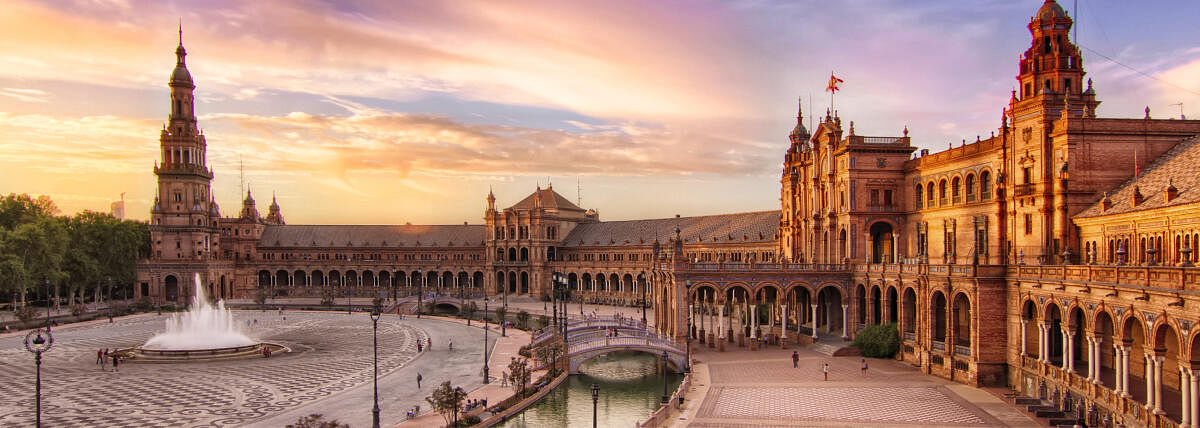

The street flamenco performers hold the visitors glued with a twirl of the skirt, a loud ‘Hola’, a rapid tap of feet, and a strum of the guitar. The scene unfolds at the entrance porch of the grand half-circle complex of Plaza de Espana, in Seville, Spain. It is however, no surprise since there are more flamenco artistes in Seville than anywhere else in Spain and the city is after all the birthplace of this Andalusian cultural art form.
Seville, the Andalusian capital and the largest city, became home to gypsies that travelled from North West parts of India between the 9th and 14th centuries and intermingled with Moors and Jews to create the unique dance form. It now hosts the biggest flamenco event in the world, La Bienal, the month-long bi-annual flamenco festival.
Seville however is not only about Flamenco. The city overflows with cultural and heritage extravagance. The best time to visit the city for a glimpse of its culture is during the Seville April Fair or Feria de Abril de Seville. Originally started in 1846, as a livestock fair, it is a colourful celebration soon after Easter or Semana Santa. The seven-day festivities begin with parades every day leading to the bull ring ‘La Plaza de Toros de la Real Maestranza’. It is here at the largest and the most important oval arena in Spain that the tradition of bullfighting continues with a passionate frenzy. Built in 1762 for traditional cavalry training, Plaza de Toros can seat 13,000 spectators. The museum of bullfighting at the arena introduces visitors to the history and evolution through paintings, clothing designed for bullfighters and objects used by toreadors.
Not far from the bullring are Alcazar, the Royal Palace and Seville Cathedral with its tall bell tower La Giralda in the old Jewish town. After the conquest of Seville by Christian Monarchs, the Seville Cathedral, the largest Gothic church, originally a grand mosque, was converted to a church with extensions in Gothic style. The new church retained the mosque’s courtyard and minaret converting it to bell tower La Giralda. The 104-metre tall tower is now Seville’s iconic symbol. Since the much-celebrated seafarer Christopher Columbus set out on his sea expeditions, funded by the monarchs of Seville, it is in this cathedral that his remains were finally interred in a unique tomb. The casket where the great voyager rests, instead of being buried under the ground, is borne by statues of the four kings of Castile, Leon, Aragon and Navarre, now modern Spain.
The royal palace Alcazar, which continues to be occupied by Spain’s royal family, was built in 1248 after destroying the Abbadid Fort Palace. The palace complex, together with the cathedral, the bell tower and the General Archives of Indies, are UNESCO World Heritage sites.
While the palace was remodelled in Gothic and Romanesque style and many of the Islamic intricate ornamentations were used for the interiors of the palace, the Alcazar, however, is most popular for the extensive use of Azulejo, the tin-glazed ceramic tiles, on its walls. The tradition of decorating walls and facades with patterns of glazed tiles dates back to the 13th century when Seville became the major centre of Hispano-Moreesque tile industry. Taken by the vibrant colours and floral and geometric patterns of the tiles, while on a visit to Seville, the Portuguese king, took with him the technique and culture of decorating walls with these Azulejo to Portugal in the early 15th century. The unique culture of the tiles is still popular in Seville. One finds shop fronts, staircases, fountains, railings etc., decorated with tiles of floral, geometric patterns, commemorative tiles, tiles painted with landscapes and even historic events and figures. Contemporary usage of these tiles is seen at Plaza de Espana. The huge half-circle Plaza de Espana was built in 1928 for the Ibero-American Exposition of 1929 to showcase Spain’s industry and technology exhibits. With architectural elements from Art Deco, Baroque, Renaissance and Moorish revival styles, the Plaza de Espana is a landmark building at the edge of Maria Luisa Park. One of the many examples of Spanish architectural heritage, the plaza has tile decorations on its alcoves, staircases, railings and the four small access bridges. At Seville, cultural and architectural heritage inspires and coexists with modernity. Like the Metropol Parasol which takes inspiration from the vaults of the cathedral. Popularly known as Las Setas or Mushrooms of Seville, the Parasol is a huge wooden structure, the largest in the world, at four levels providing shade to the open-air public plaza and museum.
Even as it develops, Seville continues to carry its legacy forward through many old traditions offering an immersive cultural feast to its visitors.